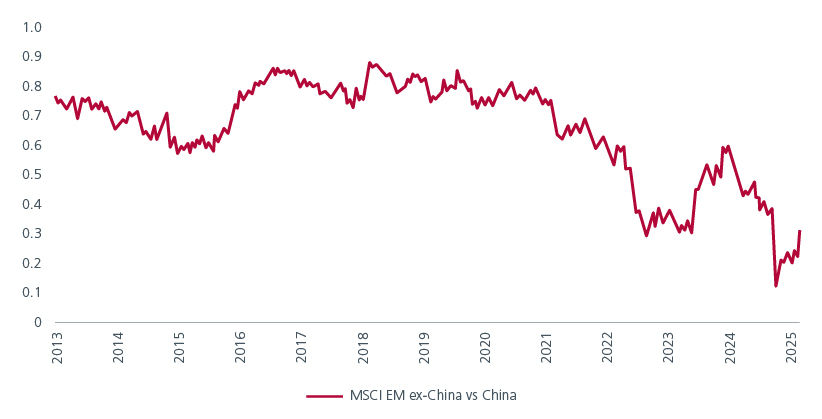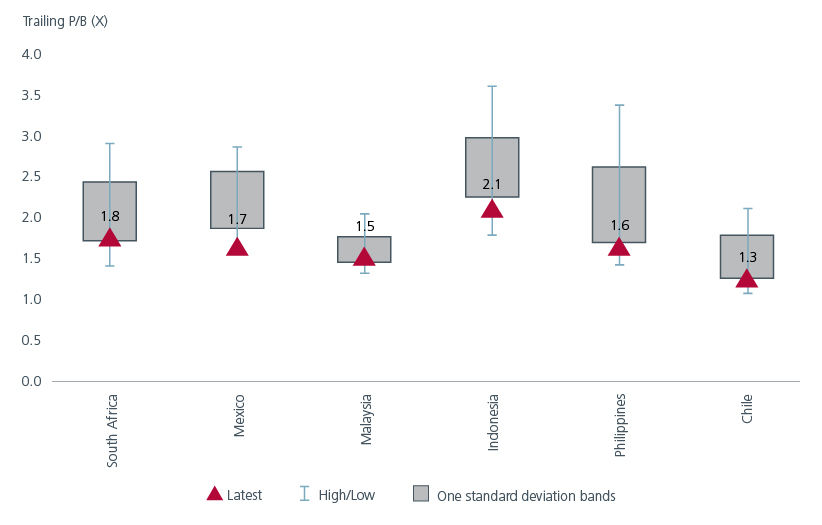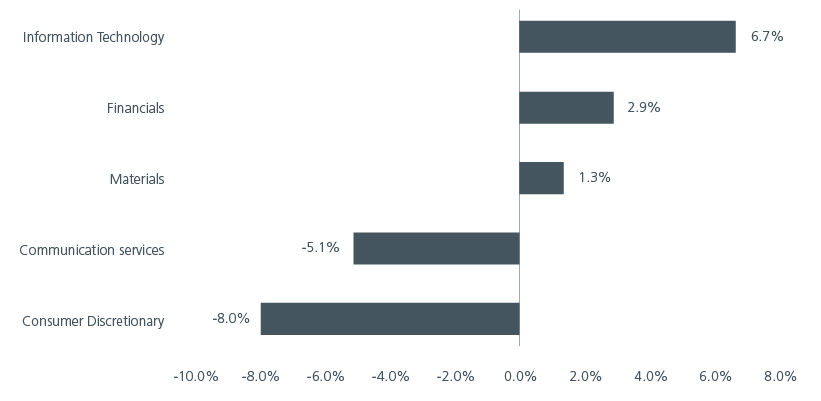Executive Summary
- Global Emerging Markets (GEMs) appear to be at an inflection point, supported by resilient earnings and a likely peak in US exceptionalism. Attractive valuations and light investor positioning set the stage for the onset of an EM bull market.
- As sentiment towards China turns more positive, a potential resurgence of the Chinese equity markets makes a GEM ex China strategy even more relevant.
- A GEM ex China strategy mitigates China’s dominance of the EM Index, taps into the attractive opportunities that exist in the other EM markets and allows investors to express their views on China independently.
The sentiment towards China appears to be turning more positive, boosted by DeepSeek’s breakthrough and Chinese policymakers’ shift towards greater support for the economy. In our view, a potential resurgence of the Chinese equity markets enhances the benefits of a GEM ex China strategy.
A GEM ex China strategy gives investors access to attractive opportunities within EMs that are otherwise crowded out by China’s dominance of the EM index, while allowing them to manage their China exposures separately. Despite Chinese equities’ attractive valuations and potential upside, other factors may influence investment decisions. With China still very underrepresented in global equity indices and portfolios, its share and dominance of the MSCI EM Index will continue to grow. A GEM ex China strategy enables investors to independently express their views on this key market.
The declining correlation between MSCI China and MSCI EM ex China shows the rising diversification benefits of a GEM ex China strategy. See Fig. 1.
Fig. 1. MSCI China rolling 52-week correlations ve MSCI EM ex China

Source: FactSet, MSCI, Goldman Sachs Global Investment Research as of 7 March 2025. Charts are for illustrative purposes only. The index described is unmanaged and not available for direct investment.
China’s large weighting (30.7%1 ) in the MSCI EM Index means that it has a large influence on EM returns. EM equities’ underperformance relative to Developed Market (DM) equities over the last 10 years was driven mostly by the Chinese market’s weakness and the US equities’ exceptional performance. The returns are more comparable if we exclude China and the US. See Fig. 2.
Fig. 2. Comparison of 10-yr annualised returns

Source: MSCI. As of end February 2025.
Spread your nets wider
By excluding China from the GEM universe, investors can potentially access opportunities in other EM markets which may be overlooked in a traditional GEM strategy. Some of these markets are currently trading close to 1 standard deviation below their 10-year average valuations on a price to book basis. See Fig 3.
Fig. 3. Price to book valuations of selected EM markets

Source: Factset, MSCI, GS Global ECS Research, Eastspring Investments, Valuations as 31 December 2024. Index weights at 31 December 2024. Notes: PBx = Price-to-book ratio. Information herein is believed to be reliable at time of publication, and any opinion or estimate contained in this document may subject to change without notice.
Indonesia, for example, is forecasted to become the 4th largest economy by 2050 as it undergoes an economic transformation, partly fueled by its abundant reserves in transition metals. Indonesia’s economic growth should drive demand for consumer goods and financial services amongst its middle-class population. Meanwhile, the Brazilian market’s eye-catching valuations following last year’s poor performance are driving returns this year. While monetary tightening has impacted the economic outlook for 2025 and populist measures remain a risk, the declining government approval rates ahead of the 2026 elections have raised hopes for a new President and more rational fiscal policies. Additionally, the expectation that interest rates have peaked has boosted sentiment.
At the same time, the weightings of the technology and financial sectors are higher in a GEM ex China universe. See Fig. 4. While DeepSeek’s breakthrough has caused Chinese tech stocks to rally, our value approach leads us to find attractive opportunities in less “glamourous” names within the tech sector. Within financials, we are finding opportunities across various geographies. These opportunities are driven by prolonged higher interest rates and stronger loan growth, which is fueled by greater government and corporate capital expenditures, as well as a rise in consumer loans.
Fig. 4. Difference in sector weights – MSCI EM ex China vs MSCI EM

Source: MSCI. As of end February 2025.
More agility in a post-tariff world
Active investing has historically been more effective in the EMs versus DMs given the EMs’ market inefficiencies and lower information transparency. Going forward, active investing will probably be even more important as tariffs create primary and secondary impacts on EM countries and companies. While countries outside of China such as Mexico and Vietnam have benefitted significantly from supply chain diversification during Trump’s first term, there is now greater scrutiny by the Trump administration on countries that may be used by China to circumvent tariffs. With Mexico also in the line of tariff fire, EM investors would need strong research capabilities to navigate this complex backdrop. A GEM ex China universe may also include a greater number of small to mid- capitalisation stocks which tends to have less research coverage, hence requiring an active approach to generate alpha.
Rethinking EM allocations
Having underperformed DMs since 2010, EMs appear to be at an inflection point. This shift is supported by a potential peak in US exceptionalism and the USD, widening growth differentials versus the DMs and resilient earnings. Additionally, attractive valuations and light investor positioning set the stage for the onset of an EM bull market.
A GEM ex China strategy mitigates China’s dominance of the EM Index, taps into the attractive opportunities that exist in the other EMs and allows investors to express their views on China independently. With the rebound in Chinese equities year to date, it is even more relevant for investors to rethink their EM strategies.
Sources:
1 MSCI. As of end February 2025.
Singapore by Eastspring Investments (Singapore) Limited (UEN: 199407631H)
Australia (for wholesale clients only) by Eastspring Investments (Singapore) Limited (UEN: 199407631H), which is incorporated in Singapore, is exempt from the requirement to hold an Australian financial services licence and is licensed and regulated by the Monetary Authority of Singapore under Singapore laws which differ from Australian laws
Hong Kong by Eastspring Investments (Hong Kong) Limited and has not been reviewed by the Securities and Futures Commission of Hong Kong.
Indonesia by PT Eastspring Investments Indonesia, an investment manager that is licensed, registered and supervised by the Indonesia Financial Services Authority (OJK).
Malaysia by Eastspring Investments Berhad (200001028634/ 531241-U) and Eastspring Al-Wara’ Investments Berhad (200901017585 / 860682-K) and has not been reviewed by Securities Commission of Malaysia.
Thailand by Eastspring Asset Management (Thailand) Co., Ltd.
United States of America (for institutional clients only) by Eastspring Investments (Singapore) Limited (UEN: 199407631H), which is incorporated in Singapore and is registered with the U.S Securities and Exchange Commission as a registered investment adviser.
European Economic Area (for professional clients only) and Switzerland (for qualified investors only) by Eastspring Investments (Luxembourg) S.A., 26, Boulevard Royal, 2449 Luxembourg, Grand-Duchy of Luxembourg, registered with the Registre de Commerce et des Sociétés (Luxembourg), Register No B 173737.
Chile (for institutional clients only) by Eastspring Investments (Singapore) Limited (UEN: 199407631H), which is incorporated in Singapore and is licensed and regulated by the Monetary Authority of Singapore under Singapore laws which differ from Chilean laws.
The afore-mentioned entities are hereinafter collectively referred to as Eastspring Investments.
The views and opinions contained herein are those of the author, and may not necessarily represent views expressed or reflected in other Eastspring Investments’ communications. This document is solely for information purposes and does not have any regard to the specific investment objective, financial situation and/or particular needs of any specific persons who may receive this document. This document is not intended as an offer, a solicitation of offer or a recommendation, to deal in shares of securities or any financial instruments. It may not be published, circulated, reproduced or distributed without the prior written consent of Eastspring Investments. Reliance upon information in this document is at the sole discretion of the reader. Please carefully study the related information and/or consult your own professional adviser before investing.
Investment involves risks. Past performance of and the predictions, projections, or forecasts on the economy, securities markets or the economic trends of the markets are not necessarily indicative of the future or likely performance of Eastspring Investments or any of the funds managed by Eastspring Investments.
Information herein is believed to be reliable at time of publication. Data from third party sources may have been used in the preparation of this material and Eastspring Investments has not independently verified, validated or audited such data. Where lawfully permitted, Eastspring Investments does not warrant its completeness or accuracy and is not responsible for error of facts or opinion nor shall be liable for damages arising out of any person’s reliance upon this information. Any opinion or estimate contained in this document may subject to change without notice.
Eastspring Investments companies (excluding joint venture companies) are ultimately wholly owned/indirect subsidiaries of Prudential plc of the United Kingdom. Eastspring Investments companies (including joint venture companies) and Prudential plc are not affiliated in any manner with Prudential Financial, Inc., a company whose principal place of business is in the United States of America or with the Prudential Assurance Company Limited, a subsidiary of M&G plc (a company incorporated in the United Kingdom).














